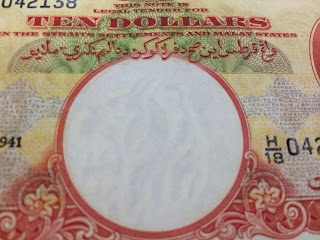They are :-
1925 $50 King George PMG 25NET
I have blogged about this magnificent piece of banknote on my previous post. You can read the previous article here ( 1925 $50 KGV ).
1901 $5 KING EDWARD VII
The first two $5 issues during the reign of Queen Victoria from 1898 to 1900 were of the same design as the other denominations throughout the series. The design of this issue from 1901 to 1924 during the reign of King Edward VII or Edwardian era are smaller in size. The reduction was implemented to better distinguish between this denomination and the $10.
Perhaps the most noticeable difference is the placement of the phase "Currency Commissioners". On the 1898 to 1900 (Queen Victoria) $5 notes, this phase is centered and the signatures are to its right, as it is the same on all the other denominations throughout the series.
However for all subsequent King Edward VII & King George V the $5 notes, these words "Currency Commissioners" are positioned on the right above the serial numbers and the signatures are on the center of the notes.
Note : there are three commissioners signatures on the notes during both reign (QV and KEVII).
1935 $10 King George V pristine UNC condition
This piece is really a gem in pristine UNC condition without any stains like it was just came out from the printer - Bradbury Wilkinson UK.
However the 1932 issues are the rarest for all denominations, especially the $5 dollars. The 1935 is the most common of the years, though the $5 dollars & $10 dollars issues are tough to find in uncirculated condition. The other years are quite scarce in high grades.
Happy reading !
Andrew












































